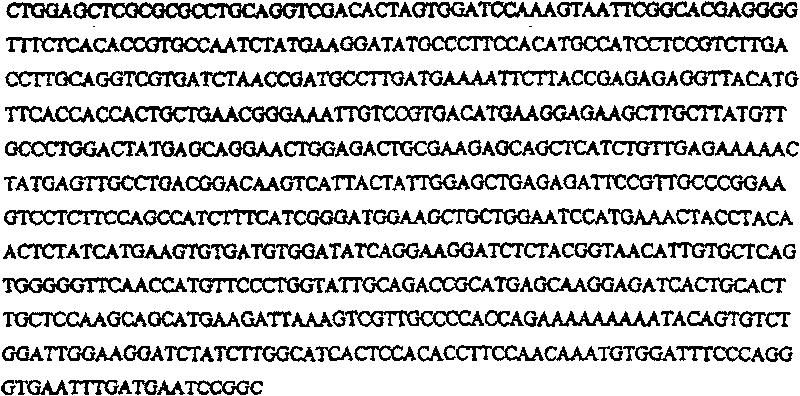Isolation and characterization of fiber-specific actin promoter from cotton
一种棉花纤维、肌动蛋白的技术,应用在植物分子学领域,能够解决纤维性质限制等问题
- Summary
- Abstract
- Description
- Claims
- Application Information
AI Technical Summary
Problems solved by technology
Method used
Image
Examples
Embodiment 1
[0018]Example 1: Isolation of fiber-specific cDNA encoding the CFACT1 sequence
[0019] Disinfect the cotton seed surface with 70% ethanol for 30-60 seconds, and 10% H 2 o 2 Disinfect for 30-60 minutes, followed by rinsing with sterile water. Seeds were germinated on 1 / 2 MS medium in a culture room at 28°C in the light, and cotyledons and hypocotyls excised from sterile seedlings were used as explants for transformation. Cotton plants were grown in pots for DNA and RNA extraction.
[0020] Total RNA was extracted from cotton nascent fibers, ovules, anthers, petals, sepals, leaves and roots using the guanidinium thiocyanate method or the SV total RNA isolation system (Promega). Poly(A)+RNA was purified by spin chromatography with oligo(dT) cellulose from the mRNA purification kit (Pharmacia Biotech). Cotton cDNA was synthesized using a cDNA synthesis kit (Pharmacia Biotech). A cotton cDNA library was constructed by inserting cDNA fragments into the ZAP expression vector (S...
Embodiment 2
[0026] Example 2: Isolation and structural analysis of the CFACT1 gene
[0027] Total DNA was extracted and purified from cotton plants using the following method. Liquid nitrogen was added to 4 g of leaf tissue and the leaves were thoroughly homogenized. 20ml frozen extraction buffer (63g / L glucose, 0.1M Tris.HCl (pH8.0), 5mM EDTA, 20g / L PVP-40, 1g / lDIECA, 1g / L ascorbic acid, 2ml / L ) was added to the homogenized tissue in a 50ml test tube and centrifuged at 2500rpm for 15 minutes. After removing the supernatant, 10 ml of lysis buffer was added to each tube. The resuspended pellet was incubated at 65°C for 30 minutes. 10 ml of chloroform was added to each tube, mixed with the samples and centrifuged at 3500 rpm for 10 minutes. Transfer the supernatant to a clean tube and perform another chloroform extraction. Transfer the supernatant to clean tubes and add 0.6 volume of isopropanol to each tube to precipitate the DNA. After centrifugation at 3500 rpm for 30 minutes, the ...
Embodiment 3
[0031] Example 3: Functional analysis of the CFACT1 promoter
[0032] To characterize the function of the CFACT1 promoter, the 0.8kb CFACT1 promoter was connected with the GUS gene in pBI101 to construct a gene expression vector ( Figure 4 ). Cotton and tobacco were transformed with Agrobacterium tumefaciens containing the CFACT1 promoter / GUS fusion gene, and the pBI121 vector containing the CaMV35S promoter / GUS fusion was used as a positive control. The CaMV35S promoter is active in all tissues of cotton and other plants and is a constitutive promoter [Odelldeng, 1985; Ow et al., 1987; McCabe and Martinell, 1993]. A binary vector containing a CFACT1 promoter / GUS fusion gene or a CaMV35S promoter / GUS fusion control was transferred into Agrobacterium tumefaciens strain LBA4404. Cotton explants for transformation were obtained from cotton seedlings grown in Example 1. Tobacco explants were obtained from tobacco seedlings. Sterilize the surface of tobacco seeds with 70% etha...
PUM
 Login to View More
Login to View More Abstract
Description
Claims
Application Information
 Login to View More
Login to View More - R&D
- Intellectual Property
- Life Sciences
- Materials
- Tech Scout
- Unparalleled Data Quality
- Higher Quality Content
- 60% Fewer Hallucinations
Browse by: Latest US Patents, China's latest patents, Technical Efficacy Thesaurus, Application Domain, Technology Topic, Popular Technical Reports.
© 2025 PatSnap. All rights reserved.Legal|Privacy policy|Modern Slavery Act Transparency Statement|Sitemap|About US| Contact US: help@patsnap.com



